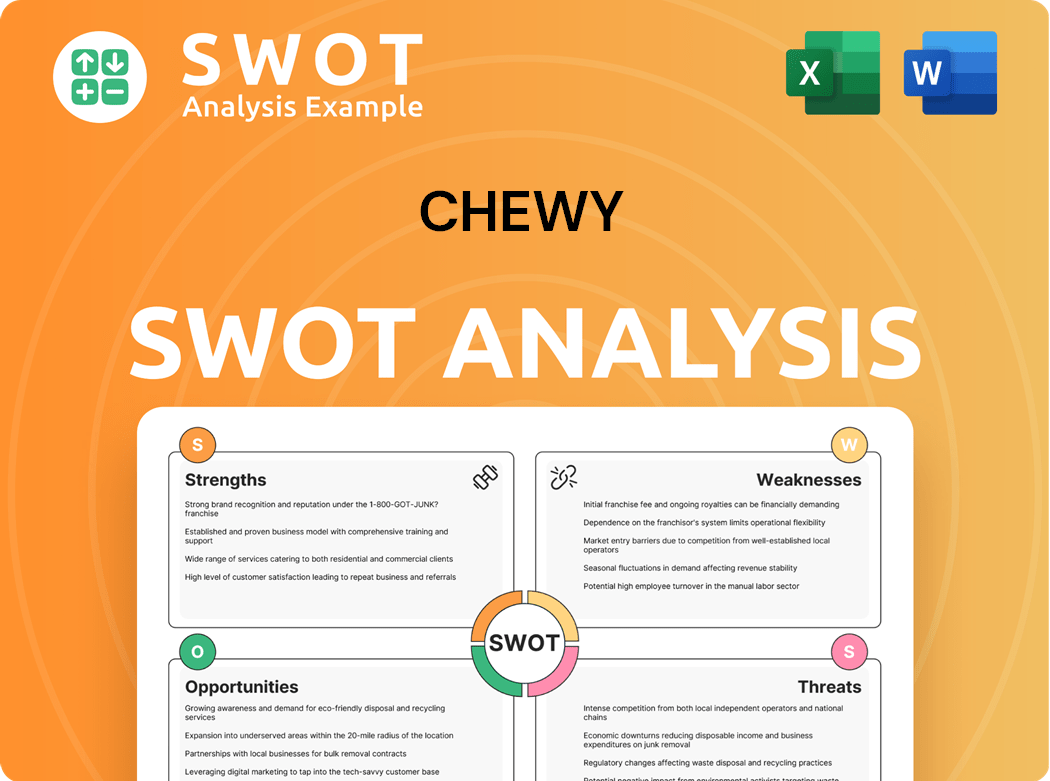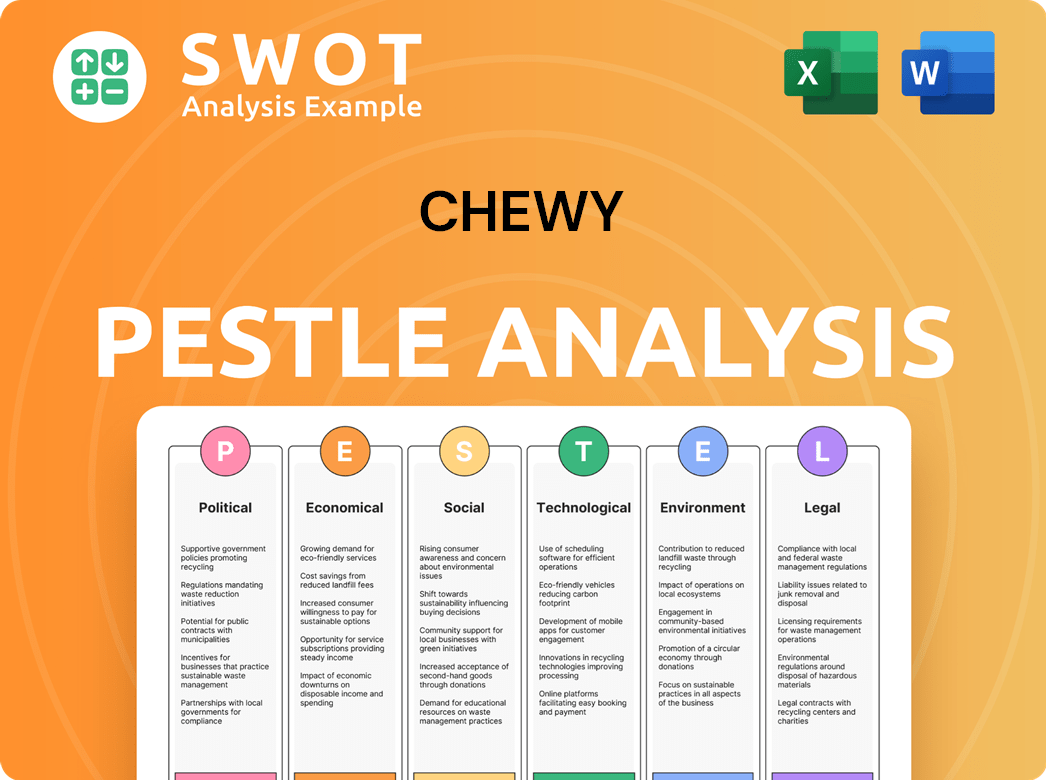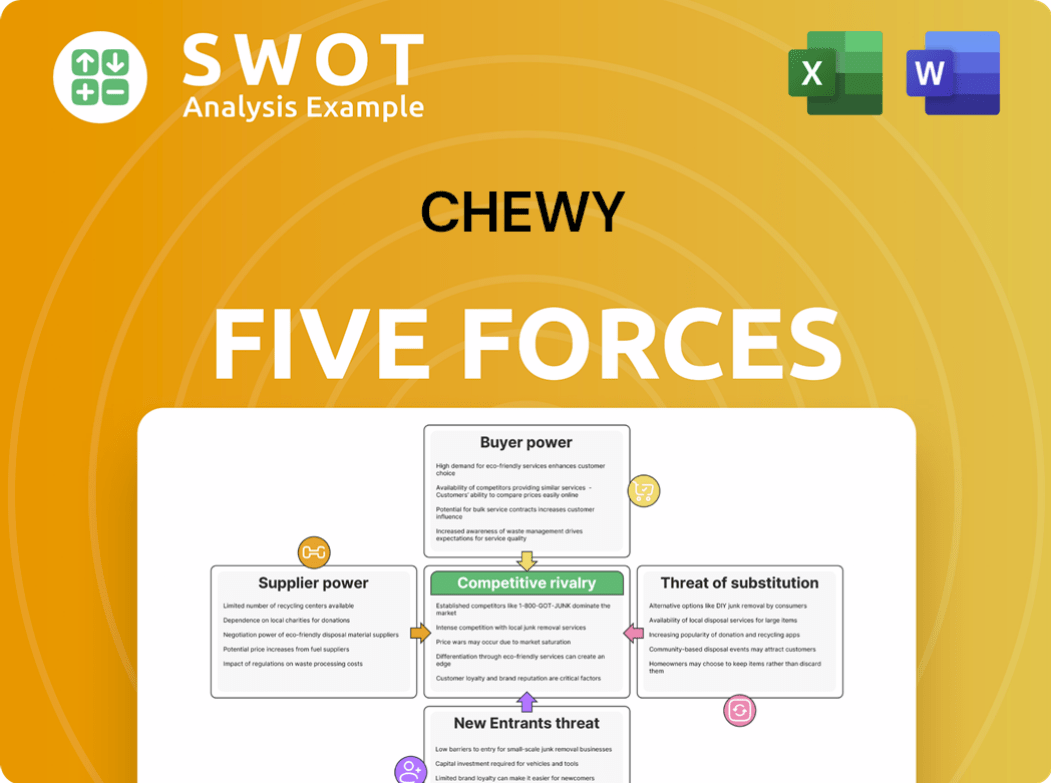Chewy Bundle
How Does Chewy Stack Up in the Pet Care E-commerce Arena?
The pet care industry is booming, and online retailers are leading the charge. Chewy, a pioneer in the e-commerce space for pet supplies, has revolutionized how pet owners purchase essentials for their furry friends. Founded in 2011, Chewy quickly gained traction by offering a vast selection of products and exceptional customer service.

This exploration delves into the Chewy SWOT Analysis, providing a comprehensive Chewy market analysis to understand its position within the pet industry. We'll dissect the Chewy competitive landscape, examining its Chewy competitors, strategic advantages, and the factors shaping its future, including online pet supplies dynamics. Understanding Chewy's business model and financial performance is crucial for investors and industry watchers alike.
Where Does Chewy’ Stand in the Current Market?
Chewy has established itself as a leading online retailer in the pet supplies sector. Its primary focus is on selling pet food, treats, and supplies, which constitute the majority of its revenue. The company also offers pet healthcare products and services, including its Chewy Health platform and Connect with a Vet telehealth service, broadening its service offerings.
The company's operations are primarily concentrated in the United States, serving a wide customer base across the country. Chewy has strategically expanded its product lines to cater to various pet types, including dogs, cats, fish, birds, and small pets, ensuring broad market appeal. Over time, Chewy has refined its positioning by emphasizing convenience, auto-ship options, and a high level of customer service, which has fostered strong customer loyalty.
Chewy's financial performance reflects its strong market position. For the fiscal year that ended on January 28, 2024, Chewy reported net sales of $11.15 billion, marking a 10.2% increase year-over-year. This growth underscores its robust standing in a competitive market. The company's strong brand recognition and robust logistics network give it a particularly strong position in the online direct-to-consumer segment of the pet care market.
Chewy holds a significant share of the online pet retail market. The company's revenue growth, as evidenced by its 10.2% increase in net sales to $11.15 billion for the fiscal year ended January 28, 2024, demonstrates its ability to capture and retain customers. This growth positions Chewy favorably within the competitive landscape.
Chewy emphasizes convenience, auto-ship options, and a high level of customer service to foster strong customer loyalty. This focus on customer experience is a key element of Chewy's business model. The company's commitment to customer satisfaction supports its market position and long-term growth.
Chewy offers a wide range of products catering to various pet types, including dogs, cats, fish, birds, and small pets. This broad product selection appeals to a diverse customer base. The company's focus on pet food, treats, and supplies, along with healthcare services, meets the comprehensive needs of pet owners.
Chewy's primary operations are within the United States, serving a broad customer base. The company's strategic expansion of product lines and services indicates a focus on growth within its core market. As the company continues to evolve, understanding the Owners & Shareholders of Chewy can provide additional insights into its strategic direction.
Chewy's strong market position is supported by its substantial revenue, customer loyalty, and comprehensive product offerings. The company's focus on customer service and convenience differentiates it in the competitive online pet supplies market. Chewy's ability to maintain consistent revenue growth and expand its services demonstrates its resilience and strategic foresight.
- Significant market share in the online pet retail sector.
- Consistent revenue growth, with $11.15 billion in net sales for the fiscal year ended January 28, 2024.
- Emphasis on customer service, auto-ship options, and convenience.
- Broad product offerings catering to various pet types.
Chewy SWOT Analysis
- Complete SWOT Breakdown
- Fully Customizable
- Editable in Excel & Word
- Professional Formatting
- Investor-Ready Format

Who Are the Main Competitors Challenging Chewy?
The Chewy competitive landscape is dynamic, with a mix of established e-commerce giants, brick-and-mortar retailers, and specialized online stores vying for market share in the pet industry. Understanding Chewy's competitors is crucial for analyzing its market position and growth potential. This analysis helps in evaluating Chewy's strategies and its ability to sustain its competitive edge.
Chewy's market share analysis reveals a constantly evolving competitive environment, where success hinges on factors like pricing, product range, customer service, and delivery speed. The competition also extends to emerging direct-to-consumer brands and local pet stores, each with unique strengths and strategies. This competitive pressure influences Chewy's business model and its ongoing efforts to attract and retain customers.
Chewy's main competitors 2024 include a diverse range of companies, each with its own strengths and strategies. The competitive landscape is shaped by the e-commerce sector's growth and the increasing demand for pet products and services. Chewy's ability to navigate this competitive environment will be key to its future financial performance.
Amazon, particularly through its Amazon Pet Supplies section, is a major competitor. Its vast reach, extensive logistics network, and competitive pricing pose a constant challenge. Amazon's ability to bundle pet supplies with other purchases and offer fast delivery significantly impacts Chewy's customer acquisition strategy.
PetSmart, Chewy's former parent company, operates a robust online presence and a large network of physical stores. PetSmart offers services like grooming and training, which Chewy does not directly provide. This omnichannel approach allows PetSmart to capture a broader customer base.
Petco has a strong omnichannel presence, offering a wide range of products and services, including veterinary care and grooming. This allows Petco to compete on convenience and comprehensive pet care solutions. Petco's ability to provide in-store experiences and services differentiates it from Chewy.
Smaller, specialized online retailers focus on niche pet products. These retailers often emphasize personalized service and community engagement. They can compete by offering unique products and building strong customer relationships.
Supermarkets and mass merchandisers like Walmart and Target also carry pet supplies. These stores leverage their existing customer base and physical footprint. They often compete on price and convenience.
Emerging direct-to-consumer brands specialize in premium or natural pet foods. These brands often utilize subscription models. They focus on product quality and direct customer relationships.
The battles in the online pet supplies market often revolve around several key factors. These factors determine Chewy's competitive advantages and its ability to maintain its market share.
- Pricing: Competitors constantly adjust prices to attract customers.
- Product Selection: A wide and diverse product range is essential.
- Speed of Delivery: Fast and reliable shipping is a key differentiator.
- Customer Experience: Excellent customer service and support are crucial.
- Subscription Models: Recurring revenue through subscriptions is increasingly important.
Chewy PESTLE Analysis
- Covers All 6 PESTLE Categories
- No Research Needed – Save Hours of Work
- Built by Experts, Trusted by Consultants
- Instant Download, Ready to Use
- 100% Editable, Fully Customizable

What Gives Chewy a Competitive Edge Over Its Rivals?
Understanding the Revenue Streams & Business Model of Chewy provides a foundation for analyzing its competitive advantages within the dynamic pet industry. The company has carved a niche by focusing intently on customer experience and offering a wide array of products tailored for pet owners. This approach has allowed it to gain a significant foothold in the e-commerce sector, specifically within the online pet supplies market.
Key to Chewy's success is its commitment to building a loyal customer base. This is achieved through personalized service, including features like auto-ship programs and responsive customer support. Furthermore, Chewy's strategic investments in its e-commerce infrastructure, including fulfillment centers and a proprietary technology platform, have enhanced its ability to meet customer needs efficiently and effectively. These elements are crucial in understanding its competitive edge.
Chewy's competitive advantages are multi-faceted, combining superior customer service, a vast product selection, and efficient operations. These strengths are particularly relevant when conducting a Chewy market analysis and assessing its position relative to its competitors. The company’s ability to maintain high customer retention rates and expand its market share highlights the effectiveness of its strategic approach.
Chewy's customer service is a key differentiator. It includes personalized touches like handwritten cards and quick issue resolution. This focus fosters high customer loyalty and strong word-of-mouth marketing, which are essential in the online pet supplies sector.
Chewy offers over 100,000 products from more than 3,000 brands. This wide variety includes private label brands, ensuring a comprehensive selection for pet owners. This extensive inventory supports its competitive position in the pet industry.
Chewy's proprietary technology platform and strategically located fulfillment centers enable rapid delivery. This is crucial for perishable pet food and urgent supplies. The efficient supply chain management supports its competitive advantages.
Chewy expands its offerings beyond products with services like Chewy Health and Connect with a Vet. These services create a more holistic value proposition for pet parents. This diversification enhances its competitive position.
Chewy's competitive advantages, particularly customer loyalty and a specialized offering, have proven sustainable. However, they face ongoing threats from generalist retailers and new entrants. Understanding these dynamics is key to a thorough Chewy competitive landscape analysis.
- Customer Loyalty: High customer retention rates due to exceptional service.
- Specialized Offering: Focus on the pet category allows for deep understanding of customer needs.
- E-commerce Infrastructure: Efficient supply chain and technology platform support rapid delivery.
- Holistic Approach: Integration of products and healthcare services enhances value.
Chewy Business Model Canvas
- Complete 9-Block Business Model Canvas
- Effortlessly Communicate Your Business Strategy
- Investor-Ready BMC Format
- 100% Editable and Customizable
- Clear and Structured Layout

What Industry Trends Are Reshaping Chewy’s Competitive Landscape?
The pet care industry, a significant sector within the broader retail landscape, is experiencing notable shifts that impact companies like the online pet supplies retailer. Understanding these trends, along with the challenges and opportunities they present, is crucial for assessing the company's strategic positioning and future prospects. The competitive landscape, as well as the company's ability to navigate market dynamics, will determine its success.
The company faces both internal and external risks that could affect its financial performance and market position. These risks include competition from established players, economic fluctuations, and the potential for supply chain disruptions. However, the company also has opportunities for growth, particularly in expanding its service offerings and exploring new markets. A comprehensive analysis of these factors is essential for making informed investment decisions or strategic business planning.
The pet industry is witnessing a surge in e-commerce, with consumers increasingly preferring the convenience of online shopping for their pet needs. The "humanization" of pets is driving demand for premium products and specialized services. Telehealth for pets is also gaining traction, creating new avenues for customer engagement.
Intensifying competition from major retailers like Amazon and Walmart, who are investing heavily in their online pet segments, poses a significant challenge. Economic downturns and inflation could impact consumer spending on pets. Managing supply chain disruptions and rising fulfillment costs are also ongoing concerns.
Expanding into new service offerings like pet insurance and grooming services could diversify revenue streams. International expansion represents a vast untapped market. Strategic partnerships and continued investment in data analytics and AI offer opportunities for growth and efficiency.
The Chewy competitive landscape includes major players like Amazon, Walmart, and Petco. These competitors are actively expanding their online pet supply offerings. The company's ability to differentiate through customer service, product selection, and specialized services will be key to maintaining its market share.
The pet industry is a multi-billion dollar market, with e-commerce continuing to gain share. The company's customer base and repeat purchase rates are crucial indicators of its success. The company's ability to innovate and adapt to changing consumer preferences will be key to its long-term success.
- E-commerce penetration in the pet supplies market is growing rapidly, with projections indicating continued expansion.
- The humanization of pets is driving increased spending on premium pet food and health products.
- Telehealth services for pets are experiencing growing adoption rates, reflecting broader trends in digital health.
- Competition from major retailers like Amazon and Walmart is intensifying, requiring strategic differentiation.
Chewy Porter's Five Forces Analysis
- Covers All 5 Competitive Forces in Detail
- Structured for Consultants, Students, and Founders
- 100% Editable in Microsoft Word & Excel
- Instant Digital Download – Use Immediately
- Compatible with Mac & PC – Fully Unlocked

Related Blogs
- What are Mission Vision & Core Values of Chewy Company?
- What is Growth Strategy and Future Prospects of Chewy Company?
- How Does Chewy Company Work?
- What is Sales and Marketing Strategy of Chewy Company?
- What is Brief History of Chewy Company?
- Who Owns Chewy Company?
- What is Customer Demographics and Target Market of Chewy Company?
Disclaimer
All information, articles, and product details provided on this website are for general informational and educational purposes only. We do not claim any ownership over, nor do we intend to infringe upon, any trademarks, copyrights, logos, brand names, or other intellectual property mentioned or depicted on this site. Such intellectual property remains the property of its respective owners, and any references here are made solely for identification or informational purposes, without implying any affiliation, endorsement, or partnership.
We make no representations or warranties, express or implied, regarding the accuracy, completeness, or suitability of any content or products presented. Nothing on this website should be construed as legal, tax, investment, financial, medical, or other professional advice. In addition, no part of this site—including articles or product references—constitutes a solicitation, recommendation, endorsement, advertisement, or offer to buy or sell any securities, franchises, or other financial instruments, particularly in jurisdictions where such activity would be unlawful.
All content is of a general nature and may not address the specific circumstances of any individual or entity. It is not a substitute for professional advice or services. Any actions you take based on the information provided here are strictly at your own risk. You accept full responsibility for any decisions or outcomes arising from your use of this website and agree to release us from any liability in connection with your use of, or reliance upon, the content or products found herein.